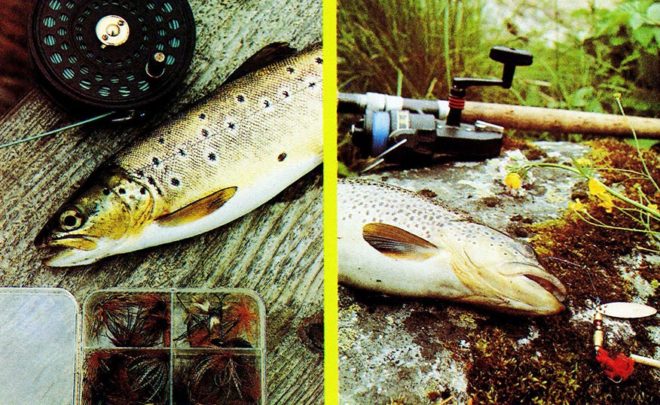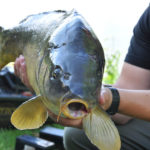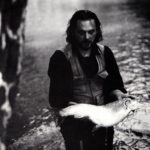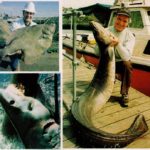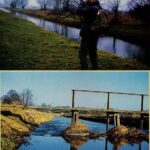Pstrąg potokowy – Salmo trutta morpha fario (L.)
angielski: BROWN TROUT
francuski: TRUITE DE RIVIERE
holenderski: BEEKFOREL
duński: BAEKORRED.
WYSTĘPOWANIE
W sposób naturalny na Podkarpaciu prawie we wszystkich rzekach dorzecza Wisły, Odry i Nysy, na Roztoczu, w pomorskich dopływach Wisły oraz w dorzeczach rzek wpadających bezpośrednio do Bałtyku. Rybę tę z powodzeniem introdukowano do wielu rzek na terenie całej Polski oraz do niektórych jezior.
WIELKOŚĆ
Średnie rozmiary: 25-40 cm (0,2-0,5 kg); rzadko: masa ponad 2,5 kg (ok. 60 cm długości). Ryby o masie ponad 5 kg pochodzą w większości przypadków z dużych jezior oraz uchodzących do nich rzek. Rekord „Wędkarstwa”: 5.53 kg i 77.5 cm.
Gdzie i kiedy
Naturalnym środowiskiem życiowym pstrągów potokowych, co wskazuje już sama nazwa gatunkowa tych ryb, są śródłąkowe strumienie oraz górskie i podgórskie potoki.
Pstrągi potokowe preferują rzeki o żwirowym dnie, aby zimą móc skutecznie się wytrzeć; najchętniej zajmują stanowiska w burtach podmytych brzegów i w głębokich dołkach, gdyż tylko w pewnej kryjówce czują się bezpieczne; potrzebują dużej ilości tlenu w wodzie, w związku z czym najlepiej się czują w szybko płynących ciekach.
Jeżeli w wodzie płynącej żyje dużo larw owadów, licznie występują głowacze i różanki oraz trochę wścibskich lipieni i wszędobylskich kleni, to jest to klasyczny ciek pstrągowy. Niekoniecznie musi być to od razu potok lub strumień. Pstrągi potokowe spotyka się także w niektórych czystych jeziorach oraz w górskich zbiornikach zaporowych. W bogatej w pokarm naturalny wodzie stojącej pstrągi potokowe osiągają rozmiary troci jeziorowych -dorastają nawet do 5-10 kg, mają krępą budowę ciała jak karpie i rzadko kiedy udaje się u nich doszukać tak charakterystycznych dla tego gatunku czerwonych kropek na bokach ciała. Sezon na pstrągi potokowe nie trwa zbyt długo. Okres ochronny zaczyna się we wrześniu a kończy w styczniu. Na początku sezonu (praktycznie aż do końca marca) pstrągi nie są jeszcze w najlepszej kondycji po odbyciu wyczerpującego tarła – są wychudzone, sama głowa i ogon, prawie w ogóle nie walczą podczas holu. Na wiosnę zmienia się to jednak z tygodnia na tydzień – ryby szybko nabierają masy i gromadzą zapasy energii na przetrwanie następnej surowej zimy. Pierwszym przełomowym momentem w siedmiomiesięcznej „kuracji podtuczającej” są masowe wyloty tłustych jętek majowych na początku czerwca. Niestety, ten odwieczny rytuał przyrody, tak elektryzujący wędkarzy muchowych, z roku na rok odbywa się na coraz mniejszą skalę. Wszystkiemu winne są coraz większe zanieczyszczenia oraz ciągłe regulowanie rzek. Masowe wyloty oraz rójki jętek są dziś coraz rzadsze. Wrażliwe pstrągi potokowe też są zagrożone – bez intensywnych zarybień już dawno zniknęłyby z wielu naszych rzek.
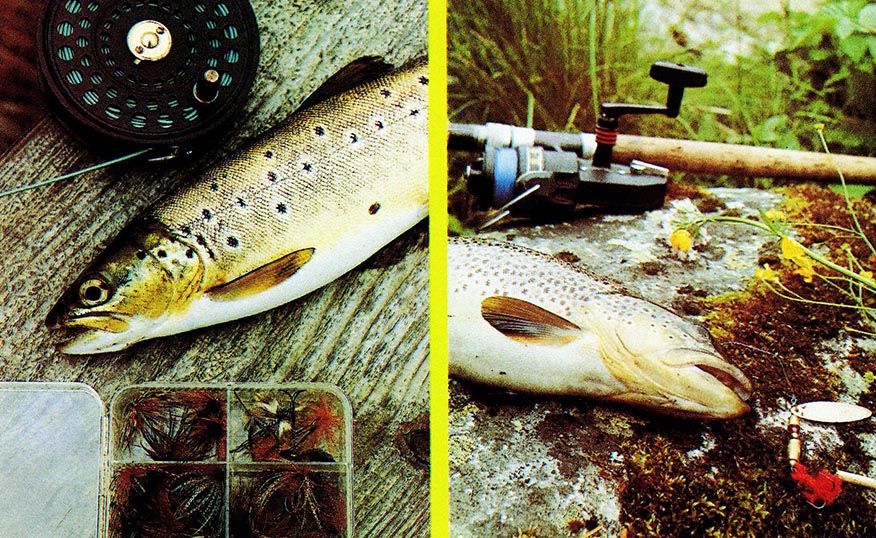 Sztuczna mucha: dla wielu wędkarzy najpiękniejszy sposób łowienia pstrągów potokowych. Szczególnie podniecające jest łowienie potokowców na dużą sztuczną suchą muchę w okresach wylotów jętek i chruścików.
Sztuczna mucha: dla wielu wędkarzy najpiękniejszy sposób łowienia pstrągów potokowych. Szczególnie podniecające jest łowienie potokowców na dużą sztuczną suchą muchę w okresach wylotów jętek i chruścików.
Spinning: najlepszą przynętą na szybki prąd wody jest wirówka. Wytwarzane przez skrzydełko obrotówki drgania oraz refleksy świetlne prowokują pstrąga do brania.
